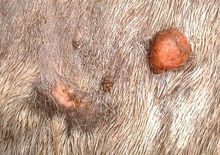The Virginia-Maryland Regional College of Veterinary Medicine at Virginia Tech is involved in a study of a new treatment for sarcoids in horses. These skin tumors are almost always benign, but they can be aggressive and treating them sometimes makes them worse.

Sarcoids on horse's skin
Although sarcoids invade only the skin and don’t affect other organs of the body, they often recur, can become worse with treatment, and can appear in other areas on the horse's body.
© 2013 by Malcolm Morley
Fortunately sarcoids are not deadly as melanomas, a cancerous skin mass, often are.
The new treatment is called H-FIRE, which stands for high-frequency irreversible electroporation. It involves a long needle that delivers a short burst of electricity into specific places in the tumor.
“Sarcoids are locally invasive skin tumors that we deal with often in equine medicine,” said Dr. J. Michael Cissell, the veterinarian leading Paco’s treatment. “Due to sarcoids’ invasiveness, simple removal is not always effective even when we remove wide margins of tissue that may be involved.”
Currently the researchers and veterinarians studying the treatment have found that H-FIRE is effective at controlling the tumor’s growth.
“Paco is the first sarcoid patient we have treated using the H-FIRE system,” Cissell said. “We’re still assessing the actual effect of H-FIRE on these tumors but it may be that it helps to decrease the periphery of the lesion making removal more successful.”
In all, seven horses have been clinical trial patients for H-FIRE for various types of tumors. Paco is a veteran having had the treatment a dozen times for lesions along his right jaw.
Although sarcoids invade only the skin and don’t affect other organs of the body, they very often recur, can become worse with treatment, and can appear in other areas than the initial site.
“Management of sarcoids can be difficult even though there are several treatment protocols available,” according to Cissell. “All of the currently used treatments have their limitations. Adding to the removal problems is the fact that sometimes just attempting sarcoid treatment can activate the tumor and cause it to grow.”
The bioengineering team that developed H-FIRE and the veterinary team that is using it in the equine clinical trials plan to start trying it on melanomas and squamous cell carcinomas, both malignant tumors, that both horses and humans can develop.
To do this and to refine the treatment on horses with sarcoids, they need a larger generator. The generator delivers the electric pulses and must be custom made. Funding for that currently isn’t available, according to Rafael Davalos, who leads the research team from the Virginia Tech-Wake Forest University School of Biomedical Engineering and Science.
“One of the challenges is the generator isn’t as powerful as we’d like for a horse,” said Davalos. “With a larger one, we wouldn’t have to do as many treatments. A custom-built pulse generator would cost $50,000 to $60,000.”
Paco has undergone all of the treatments currently available to fight sarcoids. His tumor first appeared about the size of a silver dollar one his right jawline when he was about 4 years old. It didn’t become a problem until about two years later when he scraped it on a tree while he was on a trail ride.
“Every time we’d treat the sarcoid with traditional methods, it came back as big as a fist in a week,” Paco's owner Ferd Powell said. "The tumor has continued to recur although sometimes in a spot adjacent to the last one treated."
The needle that carries the pulsating 800-850-volt electric charge to the tumor stays in each spot three minutes and then is re-inserted about a centimeter away. It doesn’t burn the horse because it isn’t a continuous charge and it’s only focused on the tumor cells. The electric pulse is one burst of energy per second with each burst lasting about 100 microseconds.
Paulo Garcia, a member of the bioengineering research team who was monitoring Poco’s vital signs throughout a recent treatment, said that the actual charge feels like a mosquito bite. A local anesthetic is given before the treatment.
Cissell and Davalos said being able to perform this treatment with just local anesthesia so the horse can remain standing is one advantage of H-FIRE. They believe that this treatment method may be applicable for other types of tumors and diseases in which it’s necessary for the patient awake to measure effectiveness of a procedure.
H-FIRE isn’t available for commercial use now and the cost to the public once it is hasn’t been set. However, more openings for the clinical test are available. The patients for the trial are those horses for whom traditional treatments have been ineffective. The veterinarians and the biomedical engineering team say they hope to test the new treatment on 15 more horses in the next year.
